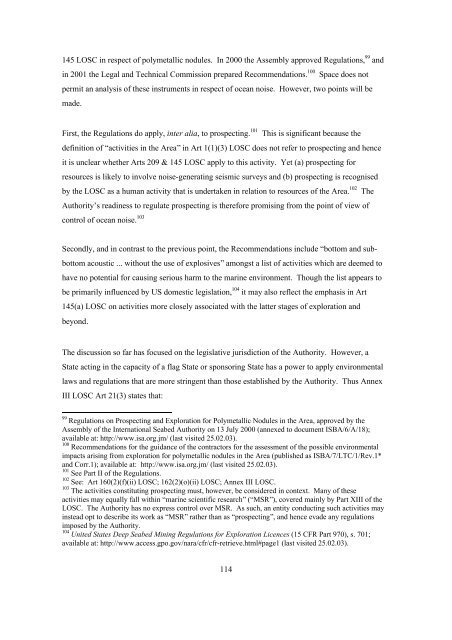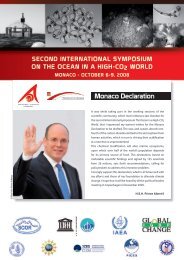Oceans of noise - Whale and Dolphin Conservation Society
Oceans of noise - Whale and Dolphin Conservation Society
Oceans of noise - Whale and Dolphin Conservation Society
- No tags were found...
Create successful ePaper yourself
Turn your PDF publications into a flip-book with our unique Google optimized e-Paper software.
145 LOSC in respect <strong>of</strong> polymetallic nodules. In 2000 the Assembly approved Regulations, 99 <strong>and</strong>in 2001 the Legal <strong>and</strong> Technical Commission prepared Recommendations. 100 Space does notpermit an analysis <strong>of</strong> these instruments in respect <strong>of</strong> ocean <strong>noise</strong>. However, two points will bemade.First, the Regulations do apply, inter alia, to prospecting. 101 This is significant because thedefinition <strong>of</strong> “activities in the Area” in Art 1(1)(3) LOSC does not refer to prospecting <strong>and</strong> henceit is unclear whether Arts 209 & 145 LOSC apply to this activity. Yet (a) prospecting forresources is likely to involve <strong>noise</strong>-generating seismic surveys <strong>and</strong> (b) prospecting is recognisedby the LOSC as a human activity that is undertaken in relation to resources <strong>of</strong> the Area. 102 TheAuthority’s readiness to regulate prospecting is therefore promising from the point <strong>of</strong> view <strong>of</strong>control <strong>of</strong> ocean <strong>noise</strong>. 103Secondly, <strong>and</strong> in contrast to the previous point, the Recommendations include “bottom <strong>and</strong> subbottomacoustic ... without the use <strong>of</strong> explosives” amongst a list <strong>of</strong> activities which are deemed tohave no potential for causing serious harm to the marine environment. Though the list appears tobe primarily influenced by US domestic legislation, 104 it may also reflect the emphasis in Art145(a) LOSC on activities more closely associated with the latter stages <strong>of</strong> exploration <strong>and</strong>beyond.The discussion so far has focused on the legislative jurisdiction <strong>of</strong> the Authority. However, aState acting in the capacity <strong>of</strong> a flag State or sponsoring State has a power to apply environmentallaws <strong>and</strong> regulations that are more stringent than those established by the Authority. Thus AnnexIII LOSC Art 21(3) states that:99 Regulations on Prospecting <strong>and</strong> Exploration for Polymetallic Nodules in the Area, approved by theAssembly <strong>of</strong> the International Seabed Authority on 13 July 2000 (annexed to document ISBA/6/A/18);available at: http://www.isa.org.jm/ (last visited 25.02.03).100 Recommendations for the guidance <strong>of</strong> the contractors for the assessment <strong>of</strong> the possible environmentalimpacts arising from exploration for polymetallic nodules in the Area (published as ISBA/7/LTC/1/Rev.1*<strong>and</strong> Corr.1); available at: http://www.isa.org.jm/ (last visited 25.02.03).101 See Part II <strong>of</strong> the Regulations.102 See: Art 160(2)(f)(ii) LOSC; 162(2)(o)(ii) LOSC; Annex III LOSC.103 The activities constituting prospecting must, however, be considered in context. Many <strong>of</strong> theseactivities may equally fall within “marine scientific research” (“MSR”), covered mainly by Part XIII <strong>of</strong> theLOSC. The Authority has no express control over MSR. As such, an entity conducting such activities mayinstead opt to describe its work as “MSR” rather than as “prospecting”, <strong>and</strong> hence evade any regulationsimposed by the Authority.104 United States Deep Seabed Mining Regulations for Exploration Licences (15 CFR Part 970), s. 701;available at: http://www.access.gpo.gov/nara/cfr/cfr-retrieve.html#page1 (last visited 25.02.03).114




